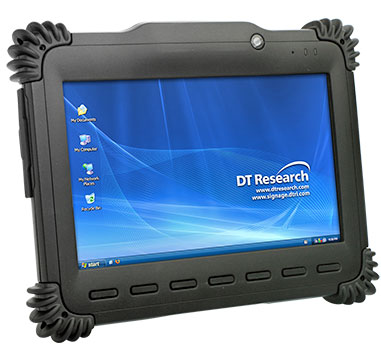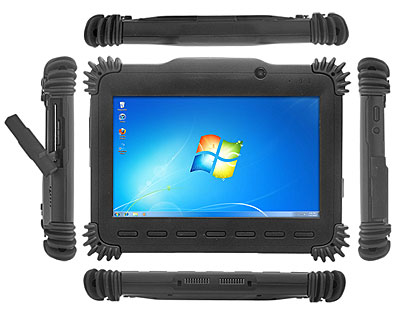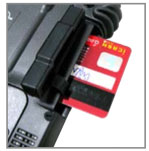|
DT Research DT395
Modern netbook-class performance in a rugged and highly configurable tablet format
(by Conrad H. Blickenstorfer)
The DT Research DT395 represents yet another addition to the San Jose, CA, based company's remarkably large roster of ruggedized Windows tablets for point-of-sale and numerous other industry applications. This one has a 9-inch wide-format display, weighs under 2.5 pounds, has a wealth of data capture and communications options, and provides good performance with a dual-core Intel Atom N2800 processor.

While each DT Research tablet looks a bit different, they all share designs with rounded edges and corners, dark-gray or black housings, and prominently ribbed protective bumpers either on all four corners or along the left and right side. This gives them an industrial tool-for-the-job look very different from that of consumer media tablets.

What the DT395 offers, in particular, is is full Windows 7 (or its embedded version) on what could be described as a second generation netbook screen, i.e. 1024 x 600 pixel resolution in 17:10 wide format. The Atom N2800 provides much better performance than earlier Atom processors, including decent graphics speed, and its power draw is small enough to give this unit decent battery life. So in essence users get the functionality of a full Windows netbook in tablet form, plus a wealth of options and accessories to customize the tablet for whatever job it's intended to be used.
Measuring 10.0 x 7.7 inches, the DT395 has about the footprint of an Apple iPad. With its ruggedized construction and expansion, though, it's considerably thicker (1.3 inches) and heavier (2.43 pounds) than consumer tablets, but smaller and lighter than traditional full-size vertical market Tablet PCs. The ergonomically shaped ABS + PC body with its rubber bumpers is grippy and easy to hold and operate (oh, and if you ever wondered what ABS + PC stands for, it's a tough resin blended from policarbonate and Acrylonitrile Butadiene Styrene polymer...).
 Like most vertical market/industrial tablets, the DT395, which comes with a smart card reader and an SD card reader, can be equipped with a variety of data capture options. Depending on your needs, the device may include a CMOS 2D area imager, a 3-track magnetic stripe reader, and front and rear cameras (2mp and 5mp with LED illuminator, respectively). On the wireless communications side, the DT395 can be ordered with a PCIe-based Gobi 3G WWAN module that includes GPS for positioning and navigation as well. There's also an optional external battery pack that doubles the internal battery's relatively modest 28 watt hours to 56 watt hours. Like most vertical market/industrial tablets, the DT395, which comes with a smart card reader and an SD card reader, can be equipped with a variety of data capture options. Depending on your needs, the device may include a CMOS 2D area imager, a 3-track magnetic stripe reader, and front and rear cameras (2mp and 5mp with LED illuminator, respectively). On the wireless communications side, the DT395 can be ordered with a PCIe-based Gobi 3G WWAN module that includes GPS for positioning and navigation as well. There's also an optional external battery pack that doubles the internal battery's relatively modest 28 watt hours to 56 watt hours.
On the ruggedness side, the tough ABS + PC enclosure combined with those rubber bumpers allow this tough tablet to handle quite a bit of abuse. The specs state IP65 sealing (total protection agains dust, protection against low-pressure water jets from all directions, with limited ingress permitted). There are references to MIL-STD-810G but, at least in the specs, few specifics. The standard operating temperature range of 32 to 104 degrees is unexceptional (heck, it routinely gets into the 110s around the RuggedPCReview.com offices near Sacramento, CA), but the optional extended -4 to 122 degree range covers most extreme deployments. As mentioned several times in reviews of DT Research products, we'd like to see more detailed environmental specs.
Overall, the DT395 is an attractive choice for anyone who needs a traditional ruggedized Windows 7 tablet that provides a nice balance between handy size and weight, battery life, and decent performance.
How do the tablets in DT Research's current tablet lineup differ? They mostly use the same or very similar electronics, but display sizes (7 to 10.4 inches), aspect ratios (standard 4:3 or wide), and resolutions (800 x 480 to 1024 x 768) vary. Most are in the 2-3 pound range, All offer good protection via large rubber bumpers, but ruggedness specs vary, as does the availability of options such as RFID, mobile broadband, cameras, etc. For good overview of the DT Research lineup, see the DT Research tablet summary, their very informative page on optional features and technologies, and their handy comparison feature..
|






